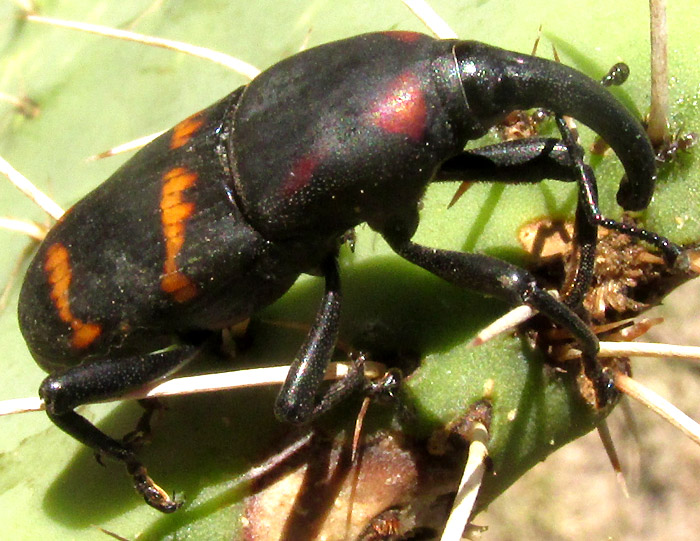Excerpts from Jim Conrad's
Naturalist Newsletter
Entry dated July 29, 2023, issued from near Tequisquiapan, elevation about 1,900m (6200 ft), Querétaro state, MÉXICO
(~N20.57°, ~W99.89°)
CACTUS WEEVIL

In dry scrub dominated by Smooth Mesquites and Cardona Pricklypear cacti, the above weevil was hard to miss. It was about 25mm long (little over an inch) and with its lack of cover on the cactus and black and orange colors, it was clearly visible against the Cardona Pricklypear's pale green surface. With that elephant-trunk-type snout, or rostrum, clearly it was a weevil, a kind of beetle: a member of the Curculionoidea Superfamily of the order Coleoptera. One doesn't expect to see such large weevils, for usually, as Wikipedia's Weevil Page says, usually they're less than 6mm long (¼ inch)

Weevils are plant eaters. They don't insert their rostrums into plant tissue, but rather at the rostrum tip bear tiny mouthparts more or less recognizable as correct for chewing beetles -- consisting of a labrum (like an upper lip), a pair of mandibles (like teeth), a pair of maxillae (pincer-like) and a labium (like a lower lip). These parts are a little like the teeth at the bottom of a drill tube, except that they bite and chew instead of rotate and grind. Note how the antennae arise from the base of the snout, the better to sense potentially edible plant tissue.
Such an exceptionally large, colorful beetle feeding on a cactus pad seemed likely to be easy to identify, and it was, simply by searching for images using the keywords "cactus weevil mexico." Immediately a matching thumbnail popped up. It was, name appropriately enough, the Cactus Weevil, CACTOPHAGUS SPINOLAE.
Cactus Weevils are well known not only because of their conspicuousness but also because they feed on cacti, which in much of Mexico are important food crops, especially the nopal Opuntia ficus-indica, in the same genus as the Cardona Pricklypear on which our weevil fed. Cactophagus spinolae occurs from central California and Arizona in the US south through Mexico's cactus-growing areas to Oaxaca. The species is represented by two subspecies, of which the subspecies validus, occurring in the US, bears no red or orange spots. It's known as California's largest weevil species. Our subspecies in the typical one, spinolae.
Adult Cactus Weevils make "bore holes" in a cactus's newer, softer joints, or pads, especially around the bases of the spines, in the areoles, as well as flowers and fruits. In the picture atop this page, note the dead tissue surrounding and in between the areoles. The 2021 study by Diana Cárdenas-Ramos and María C. Mandujano entitled "Cactus weevil (Metamasius spinolae Gyllenhal) florivore and frugivore of Opuntia cantabrigiensis Lynch (Cactaceae)," concludes that the weevil's feeding habits impacts the host in three main ways: impedes growth by damaging or destroying pads; impedes reproduction by feeding on flower buds and damaging or destroying their ability eventually to produce fruits, and; by feeding on the fruits they damage seed viability and their ability disperse.
Eggs the adults lay hatch into wormlike larvae which bore into and through the cactus joints, or pads, often killing part or all of them, which drop off.
Interestingly, Cactus Weevil damage on wild plants like ours is regarded as insignificant when compared to that in commercial fields of cacti, where up to 60% of individuals can be attacked. This information is from a Mexican government SAGARPA 2011 online document abundantly named "Programa de Trabajo de la Campaña Manejo Fitosanitario del Nopal, a operar con recursos del componente de Sanidades del Programa de Prevención y Manejo de Riesgos 2011, en el Distrito Federal."
The above information provides a classic example of the fundamental weakness of all monocultured crops, and the power of natural diversity.